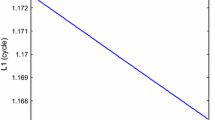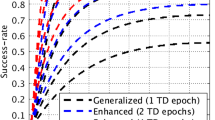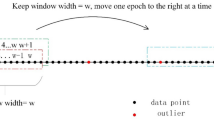Abstract
Quality control theory in terms of testing residuals has been proven to be an effective approach to deal with cycle slips. The integrated processing of multi-GNSS observations can further improve the reliability of cycle slip handling when using the residual snooping method. In this study, we investigated the integrated technique using the combined GPS/Galileo time-differenced observations for cycle slip detection and correction. Cycle slips in phase observations are detected utilizing snooping residuals from a least squares adjustment, in particular, with an assumption of student distribution for the residuals as the variance factor is unknown. For reliable cycle slip resolution, we take into account the correlation between the estimated cycle slip parameters for different satellites and systems instead of resolving the cycle slips in a satellite-by-satellite manner in case more than one satellite is flagged. These concepts were implemented within a precise point positioning (PPP) application and applied to real GPS and Galileo data collected at MGEX stations under different levels of ionospheric activity. We also tested other cycle slip handling techniques based the Hatch–Melbourne–Wübbena (HMW) and geometry-free (GF) combinations for comparison. The results demonstrated that PPP using the GPS/Galileo combined residual test detection approach can achieve better position accuracy and keep convergence even under active ionospheric condition (indicated by Kp index) compared to using the HMW- and GF-based detection methods. Moreover, cycle slip resolution using the integrated resolution scheme can lead to more precise PPP results compared to the satellite-by-satellite scheme, indicating that the correlation of cycle slip parameters between satellites could significantly affect the outcome of integer cycle slip resolution. However, more investigations are required when integrating observations from full GNSS constellations since a large computational load may degrade the efficiency at the GNSS data preprocessing stage.



















Similar content being viewed by others
References
Banville S, Langley RB (2013) Mitigating the impact of ionospheric cycle slips in GNSS observations. J Geod 87(2):179–193. https://doi.org/10.1007/s00190-012-0604-1
Blewitt G (1990) An automatic editing algorithm for GPS data. Geophys Res Lett 17(3):199–202
de Lacy MC, Reguzzoni M, Sansò F, Venuti G (2008) The Bayesian detection of discontinuities in a polynomial regression and its application to the cycle slip problem. J Geod 82(9):527–542. https://doi.org/10.1007/s00190-007-0203-8
Hatch R (1982) The synergism of GPS code and carrier measurements. In: Proceedings of the third international symposium on satellite Doppler positioning at Physical Sciences Laboratory of New Mexico State University, Feb 8–12, vol 2, pp 1213–1231
Hofmann-Wellenhof B, Lichtenegger H, Collins J (2001) Global positioning system: theory and practice. Springer, Wein
Li B, Qin Y, Liu T (2018) Geometry-based cycle slip and data gap repair for multi-GNSS and multi-frequency observations. J Geod. https://doi.org/10.1007/s00190-018-1168-5
Liu Z (2011) A new automated cycle slip detection and repair method for a single dual-frequency GPS receiver. J Geod 85(3):171–183. https://doi.org/10.1007/s00190-010-0426-y
Melbourne WG (1985) The case for ranging in GPS based geodetic systems. In: Proceedings of the 1 st international symposium on precise positioning with the global positioning system, Rockville, ML, pp 373–386
Odijk D, Teunissen PJG (2013) Characterization of between-receiver GPS-Galileo inter-system biases and their effect on mixed ambiguity resolution. GPS Solut 17(4):521–533. https://doi.org/10.1007/s10291-012-0298-0
Teunissen PJG (1995) The least-squares ambiguity decorrelation adjustment: a method for fast GPS integer ambiguity estimation. J Geod 70(1–2):65–82
Teunissen PJG (1998) Success probability of integer GPS ambiguity rounding and bootstrapping. J Geod 72(10):606–612
Teunissen PJG, Bakker PFD (2015) Multivariate integer cycle slip resolution: a single-channel analysis. In: Proceedings of the 8th Hotine-Marussi symposium mathematical geodesy, pp 33–39
Tolman B, Harris RB, Gaussiran T, Munton D, Little J, Mach R, Nelsen S, Renfro B, Schlossberg D (2004) The GPS toolkit … open source GPS software. In: Proceedings of the ION GNSS 2004, Institute of Navigation, Long Beach, CA, USA, September 21–24, pp 2044–2053
Verhagen S, Li B, Teunissen PJG (2013) Ps-LAMBDA: ambiguity success rate evaluation software for interferometric applications. Comput Geosci 54:361–376
Wübbena G (1985) Software developments for geodetic positioning with GPS using TI 4100 code and carrier measurements. In: Proceedings of the 1st international symposium on precise positioning with the global positioning system, Rockville, ML, pp 403–412
Xiao G, Mayer M, Heck B, Sui L, Zeng T, Zhao D (2018) Improved time-differenced cycle slip detect and repair for GNSS undifferenced observations. GPS Solut 22(1):6
Zhang X, Li P (2015) Benefits of the third frequency signal on cycle slip correction. GPS Solut 20(3):451–460. https://doi.org/10.1007/s10291-015-0456-2
Acknowledgements
The authors gratefully acknowledge the IGS Multi-GNSS Experiment (MGEX) for providing GNSS data and precise products, the open-source software GPSTk, its excellent design of GNSS data structure and the example of PPP application. The work is partially sponsored by the National Natural Science Foundation of China (Grant No.: 41674031) and the National Key R&D Program of China (No. 2016YFB0501803). The authors are also very grateful for the support from the Li Jiancheng academician workshop (No. 2015IC015). The numerical calculations have been carried out on the supercomputing system in the Supercomputing Center of Wuhan University. Also, many thanks to the reviewers for their valuable suggestions.
Author information
Authors and Affiliations
Corresponding author
Additional information
Publisher's Note
Springer Nature remains neutral with regard to jurisdictional claims in published maps and institutional affiliations.
Rights and permissions
About this article
Cite this article
Zhao, L., Zhu, K. & Zhang, S. Study on integrated cycle slip handling using GPS/Galileo combined observations. GPS Solut 23, 77 (2019). https://doi.org/10.1007/s10291-019-0867-6
Received:
Accepted:
Published:
DOI: https://doi.org/10.1007/s10291-019-0867-6




